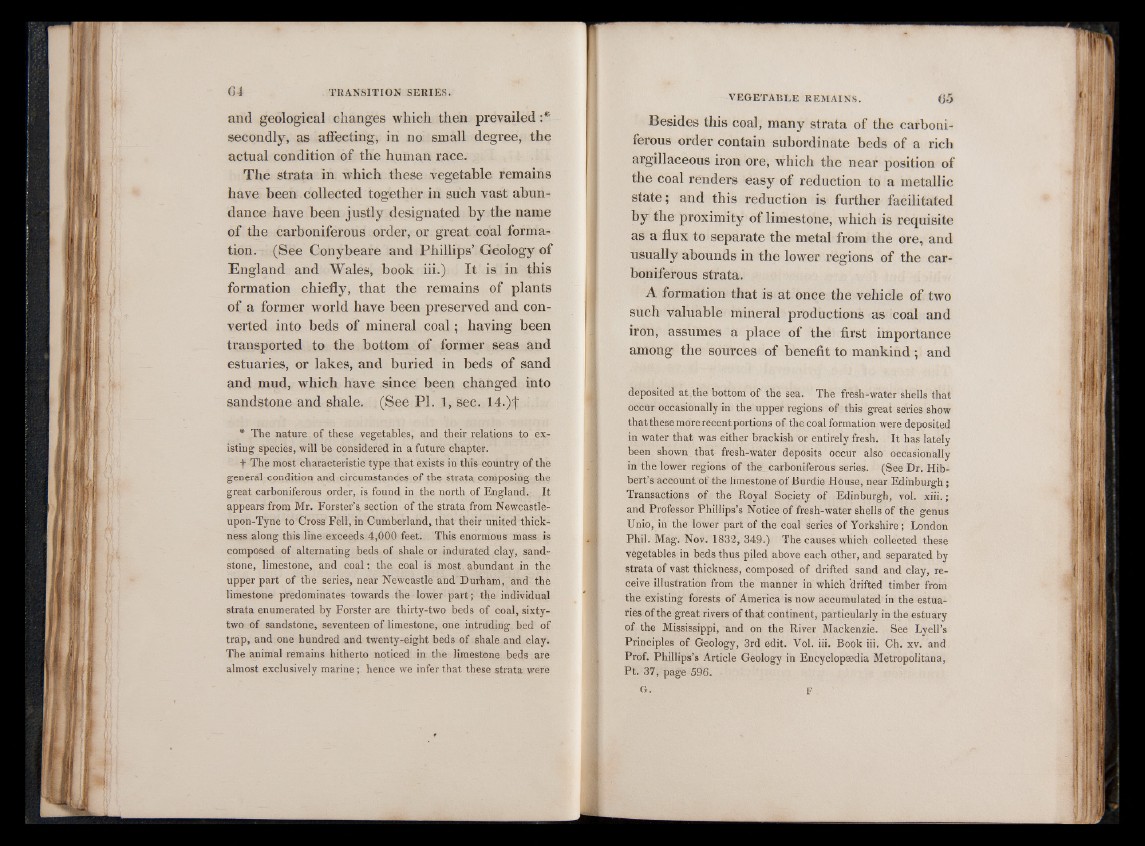
and geological changes which then prevailed :*
secondly, as affecting, in no small degree, the
actual condition of the human race.
The strata in which these vegetable remains
have been collected together in such vast abundance
have been justly designated by the name
of the carboniferous order, or great coal formation.
(See Conybeare and Phillips’ Geology of
England and Wales, book iii.) It is in this
formation chiefly, that the remains of plants
of a former world have been preserved and converted
into beds of mineral coal; having been
transported to the bottom of former seas and
estuaries, or lakes, and buried in beds of sand
and mud, which have since been changed into
sandstone and shale. (See PI. 1 , sec. 14.)f
* The nature^ of these vegetables, and their relations to existing
species, will be considered in a future chapter.
f The most characteristic type that exists in this country of the
general condition and circumstances of the strata composing the
great carboniferous order, is found in the north of England. It
appears from Mr. Forster’s section of the strata from Newcastle-
upon-Tyne to Cross Fell, in Cumberland,, that their united thickness
along this line exceeds 4,000 feet. This enormous mass is
composed of alternating beds of shale or indurated clay, sandstone,
limestone, and coal: the coal is most abundant in the
upper part of the series, near Newcastle and Durham, and the
limestone predominates towards the lower part; the individual
strata enumerated by Forster are thirty-two beds of coal, sixty-
two of sandstone, seventeen of limestone, one intruding bed of
trap, and one hundred and twenty-eight beds of shale and clay.
The animal remains hitherto noticed in the limestone beds are
almost exclusively marine; hence we infer that these strata were
VEGETABLE REMAINS. G5
Besides this coal, many strata of the carboniferous
order contain subordinate beds of a rich
argillaceous iron ore, which the near position of
the coal renders easy of reduction to a metallic
state; and this reduction is further facilitated
by the proximity of limestone, which is requisite
as a flux to separate the metal from the ore, and
usually abounds in the lower regions of the carboniferous
strata.
A formation that is at once the vehicle of two
such valuable mineral productions as coal and
iron, assumes a place of the first importance
among the sources of benefit to mankind; and
deposited at the bottom of the sea. The fresh-water shells that
occur occasionally in the upper regions of this great series show
that these more recentportions of the coal formation were deposited
in water that was either brackish or entirely fresh. It has lately
been shown, that fresh-water deposits occur also occasionally
in the lower regions of the carboniferous series. (See Dr. Hib-
bert’s account of the limestone of Burdie House, near Edinburgh ;
Transactions of the Royal Society of Edinburgh, vol. x iii.;
and Professor Phillips’s Notice of fresh-water shells of the genus
Unio, in the lower part of the coal series of Yorkshire; London
Phil. Mag. Nov. 1832, 349.) The causes which collected these
vegetables in beds thus piled above each other, and separated by
strata of vast thickness, composed of drifted sand and clay, receive
illustration from the manner in which 'drifted timber from
the existing forests of America is now accumulated in the estuaries
of the great rivers of that continent, particularly in the estuary
of the Mississippi, and on the River Mackenzie. See Lyell’s
Principles of Geology, 3rd edit. Vol. iii. Book iii. Ch. xv. and
Prof. Phillips’s Article Geology in Encyclopaedia Metropolitana,
Pt. 37, page 596.
G. F